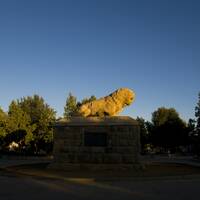There are so many historical attractions attributed to Medes and Achaemenids in Hamedan among which The Stone Lion is one of the most important. The historical statue is now placed at the end of 12 Metri Street Sang Shir in the center of a square with the same name. The hill on which the statute is today installed is an ancient one where a Parthian cemetery has been unearthed and a coffin discovered there is now on display in Ecbatana Museum. The Stone Lion used to place at the gate of Hamedan city right in front of another one. At time of the occupation of Hamedan, Arabs called the gate Bab al-Asad which means Lions’ Gate.
In 319 A.H. when Daylamites occupied the city, they completely ruined the gate. Mardavij was going to transfer one of the lions to Ray, but since it was impossible, he broke the arm of one while completely destroyed the other one. The broken statue had been fallen on the ground until 1949 when Hooshang Seyhoon, the designer architect of Tomb of Avicenna, put it in the current place while built a base made of granite for its installation. It is stated that The Stone Lions of Hamedan had been sculpted by the order of Alexander, in honor of his famous commander named Hephaestion who passed away in the same city, to be put on two sides of his tomb.
Unfortunately, the statue has witnessed the violence of people, warriors and treasure seekers over time. After a long time, The stone Lion shows almost no similarity to a lion. While the experts believe that the original one used to be quite different. However, the historical statue is still completely respected for people of Hamedan and tourists.
The current sculpture has a thin body and large head. The historical statue is about five meter long, a meter and fifteen centimeters wide and nearly a meter and twenty centimeters high. The lion has been carved from a golden black stone with a deep hole on his forehead. There are also many other holes on the back as a result of erosion by the passage of time and rainfall.
People used to believe in lion as the symbol of power and the guard of the city, a belief which has been faded today. They went to the stone lion with intent to realize their dreams, invalidate the spell and prevent cold and starvation in the past. Through performing some rituals and ceremonies, they hoped The Stone Lion to realize their dreams. Putting pebbles into the holes, pouring oil and milk on its head and face and making a pilgrimage to it just like a sacred creature were parts of these superstitions in some cases caused a lot of damages to the sculpture.
At last, The Stone Lion in Hamedan was registered in the list of Iran National Heritages on January 6, 1932.

 - Copy.jpg)
